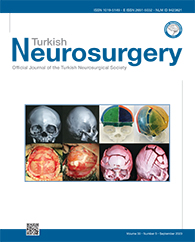2Iskenderun Technical University, Faculty of Engineering and Natural Sciences, Department of Biomedical Engineering, Hatay, Turkey
3Gaziantep University, Faculty of Health Sciences, Department of Nutrition and Dietetics, Gaziantep, Turkey
4Tekirdag State Hospital, Anesthesiology and Reanimation Clinic, Tekirdag, Turkey DOI : 10.5137/1019-5149.JTN.42560-22.2 AIM: To evaluate paraoxonase (PON), total antioxidant status (TAS), total oxidant status (TOS), high-density lipoproteins (HDL), CRP, AST, ALT, GGT, ALP levels in patients with head and multiple organ traumas.
MATERIAL and METHODS: The study included 29 male patients undergoing treatment for head and multiple organ traumas. Blood sample analysis was performed on the first, third, and seventh days after trauma.
RESULTS: The mean age, duration of hospitalization in the intensive care unit, and intubation period of the study sample was 45 years (range: 9 to 81 years), 4.29 days, and 2.94 days, respectively. One patient died, and 13 underwent surgical intervention. Comparison of PON, TAS, TOS, and CRP levels showed statistically significant differences between the first day and the third and seventh days, although no such differences were seen in HDL levels. A moderately positive correlation was observed between CRP/ AST, CRP/ALT and CRP/GGT, while a moderately negative correlation was seen between CRP/ALP.
CONCLUSION: The findings of this study suggest that some oxidative parameters may play a significant role in the prognosis and follow-up of intensive care patients. Moreover, biochemical markers can provide important information about patient response to trauma.
Keywords : Biochemical alteration, Head trauma, Multiple traumas, Total antioxidant/oxidant level




